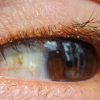Age-related macular degeneration or AMD is a medical condition where there is a loss of central vision at a place at the back of the eye called the macula. The macula is a key part of functional seeing, and a healthy macula is able to provide 6/6 or 20/20 vision. AMD may affect one’s ability to read, drive, recognise faces and perform activities that require detailed vision. Dark spots may affect vision, straight lines may become distorted and curved, and colour perception may change. Generally, AMD is caused by regular smoking, poor diet and unhealthy lifestyle.
Macular degeneration is an age-related condition. However, it should not be considered as a normal part of the aging process and should not be ignored if symptoms are present. AMD has the potential to cause blindness, and is in fact one of the most prevalent cases of blindness in Australia currently. It is estimated that 3.1% of the Australian population aged 55 years or over have AMD. Early detection of AMD is critical, as the late stage of the disease is most impairing to vision. Your optometrist is able to make the right diagnosis for a patient with presenting symptoms, with a variety of techniques and instruments. At Eyecare Network, we use the Optical Coherence Tomographer (OCT) and Retinal Photography to image the back of the eye and macular area to see the layers of the retina.
AMD involves the build up waste material at your retina. These wastes, called drusen, typically have no or little impact on vision, but in old age, they should be continually monitored for progression. Late stages of the disease may be categorised into:
-
- Dry (atrophic) macular degeneration, which leads to a gradual loss in vision. In Dry AMD, there is a gradual loss of retinal cells, and hence a slow loss of central vision.
- Wet (neovascular) macular degeneration, which leads to the formation of leaky blood vessels which can bleed at the back of the eye. Wet AMD is usually rapidly progressing and more severe for vision. Loss of vision in one eye may go unnoticed if vision in the other eye is good.There is currently no treatment available for the dry form of the condition.
However, for wet AMD, intravitreal eye injections can be administered as a drug therapy to reduce the growth of the new blood vessels at the back of the eye. Intravitreal injections are given by an ophthalmologist, and require repeated injections. Research is still being conducted on AMD treatment. It is critical that if you are over the age of 55, you visit your optometrist every year for a full health check. If you also feel like your vision suddenly changes, call your optometrist immediately.
PREVENTION OF AMD
Not everyone will get age-related macular degeneration or AMD in old age. But certain factors may put you at a higher risk of developing the disease if you are over 55 years of age. A widely popular method for preventing AMD is to adopt the Mediterranean diet, consisting of daily portions of vegetables, fruits, legumes and cereals as well as olive oil, and minimal servings of fish, dairy products meat and alcohol. It has been confidently established within optometry circles that a healthy diet will prevent AMD. Other risk factors that enhance the prevention of AMD include: no smoking, regular physical exercise, and a body mass index (BMI) in the normal range (20-25). Our optometrists recommend healthy eating and a healthy lifestyle to prevent AMD.

To see one of our optometrists for an eye examination or to find out more, contact us on 9728 7288.






